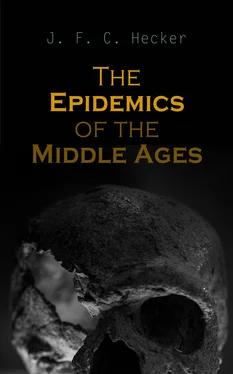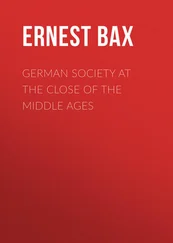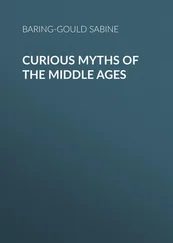In the year 1349, two hundred Flagellants first entered Strasburg, where they were received with great joy, and hospitably lodged by the citizens. Above a thousand joined the brotherhood, which now assumed the appearance of a wandering tribe, and separated into two bodies, for the purpose of journeying to the north and to the south. For more than half a year, new parties arrived weekly; and, on each arrival, adults and children left their families to accompany them; till, at length, their sanctity was questioned, and the doors of houses and churches were closed against them 117. At Spires, two hundred boys, of twelve years of age and under, constituted themselves into a Brotherhood of the Cross, in imitation of the children, who, about a hundred years before, had united, at the instigation of some fanatic monks, for the purpose of recovering the Holy Sepulchre. All the inhabitants of this town were carried away by the illusion; they conducted the strangers to their houses with songs of thanksgiving, to regale them for the night. The women embroidered banners for them, and all were anxious to augment their pomp; and at every succeeding pilgrimage, their influence and reputation increased 118.
It was not merely some individual parts of the country that fostered them: all Germany, Hungary, Poland, Bohemia, Silesia, and Flanders, did homage to the mania; and they at length became as formidable to the secular, as they were to the ecclesiastical power. The influence of this fanaticism was great and threatening; resembling the excitement which called all the inhabitants of Europe into the deserts of Syria and Palestine, about two hundred and fifty years before. The appearance, in itself, was not novel. As far back as the 11th century, many believers, in Asia and Southern Europe, afflicted themselves with the punishment of flagellation. Dominicus Loricatus, a monk of St. Croce d’Avellano, is mentioned as the master and model of this species of mortification of the flesh; which, according to the primitive notions of the Asiatic Anchorites, was deemed eminently Christian. The author of the solemn processions of the Flagellants, is said to have been St. Anthony; for even in his time (1231), this kind of penance was so much in vogue, that it is recorded as an eventful circumstance in the history of the world. In 1260, the Flagellants appeared in Italy as Devoti . “When the land was polluted by vices and crimes 119, an unexampled spirit of remorse suddenly seized the minds of the Italians. The fear of Christ fell upon all: noble and ignoble, old and young, and even children of five years of age, marched through the streets with no covering but a scarf round the waist. They each carried a scourge of leathern thongs, which they applied to their limbs, amid sighs and tears, with such violence, that the blood flowed from the wounds. Not only during the day, but even by night, and in the severest winter, they traversed the cities with burning torches and banners, in thousands and tens of thousands, headed by their priests, and prostrated themselves before the altars. They proceeded in the same manner in the villages: and the woods and mountains resounded with the voices of those whose cries were raised to God. The melancholy chaunt of the penitent alone was heard. Enemies were reconciled; men and women vied with each other in splendid works of charity, as if they dreaded, that Divine Omnipotence would pronounce on them the doom of annihilation.”
The pilgrimages of the Flagellants extended throughout all the provinces of Southern Germany, as far as Saxony, Bohemia and Poland, and even further; but at length, the priests resisted this dangerous fanaticism, without being able to extirpate the illusion, which was advantageous to the hierarchy, as long as it submitted to its sway. Regnier, a hermit of Perugia, is recorded as a fanatic preacher of penitence, with whom the extravagance originated 120. In the year 1296, there was a great procession of the Flagellants in Strasburg 121; and in 1334, fourteen years before the great mortality, the sermon of Venturinus, a Dominican friar, of Bergamo, induced above 10,000 persons to undertake a new pilgrimage. They scourged themselves in the churches, and were entertained in the market-places, at the public expense. At Rome, Venturinus was derided, and banished by the Pope to the mountains of Ricondona. He patiently endured all—went to the Holy Land, and died at Smyrna, 1346 122. Hence we see that this fanaticism was a mania of the middle ages, which, in the year 1349, on so fearful an occasion, and while still so fresh in remembrance, needed no new founder; of whom, indeed, all the records are silent. It probably arose in many places at the same time; for the terror of death, which pervaded all nations and suddenly set such powerful impulses in motion, might easily conjure up the fanaticism of exaggerated and overpowering repentance.
The manner and proceedings of the Flagellants of the 13th and 14th centuries, exactly resemble each other. But, if during the Black Plague, simple credulity came to their aid, which seized, as a consolation, the grossest delusion of religious enthusiasm, yet it is evident that the leaders must have been intimately united, and have exercised the power of a secret association. Besides, the rude band was generally under the control of men of learning, some of whom at least, certainly had other objects in view, independent of those which ostensibly appeared. Whoever was desirous of joining the brotherhood, was bound to remain in it thirty-four days, and to have four pence per day at his own disposal, so that he might not be burthensome to any one; if married, he was obliged to have the sanction of his wife, and give the assurance that he was reconciled to all men. The Brothers of the Cross, were not permitted to seek for free quarters, or even to enter a house without having been invited; they were forbidden to converse with females; and if they transgressed these rules, or acted without discretion, they were obliged to confess to the Superior, who sentenced them to several lashes of the scourge, by way of penance. Ecclesiastics had not, as such, any pre-eminence among them; according to their original law, which, however, was often transgressed, they could not become Masters, or take part in the Secret Councils . Penance was performed twice every day: in the morning and evening, they went abroad in pairs, singing psalms, amid the ringing of the bells; and when they arrived at the place of flagellation, they stripped the upper part of their bodies and put off their shoes, keeping on only a linen dress, reaching from the waist to the ancles. They then lay down in a large circle, in different positions, according to the nature of their crime: the adulterer with his face to the ground; the perjurer on one side, holding up three of his fingers, &c., and were then castigated, some more and some less, by the Master, who ordered them to rise in the words of a prescribed form 123. Upon this, they scourged themselves, amid the singing of psalms and loud supplications for the averting of the plague, with genuflexions, and other ceremonies, of which contemporary writers give various accounts; and at the same time constantly boasted of their penance, that the blood of their wounds was mingled with that of the Saviour 124. One of them, in conclusion, stood up to read a letter, which it was pretended an angel had brought from heaven, to St. Peter’s church, at Jerusalem, stating that Christ, who was sore displeased at the sins of man, had granted, at the intercession of the Holy Virgin and of the angels, that all who should wander about for thirty-four days and scourge themselves, should be partakers of the Divine grace 125. This scene caused as great a commotion among the believers as the finding of the holy spear once did at Antioch; and if any among the clergy inquired who had sealed the letter? he was boldly answered, the same who had sealed the Gospel!
Читать дальше










